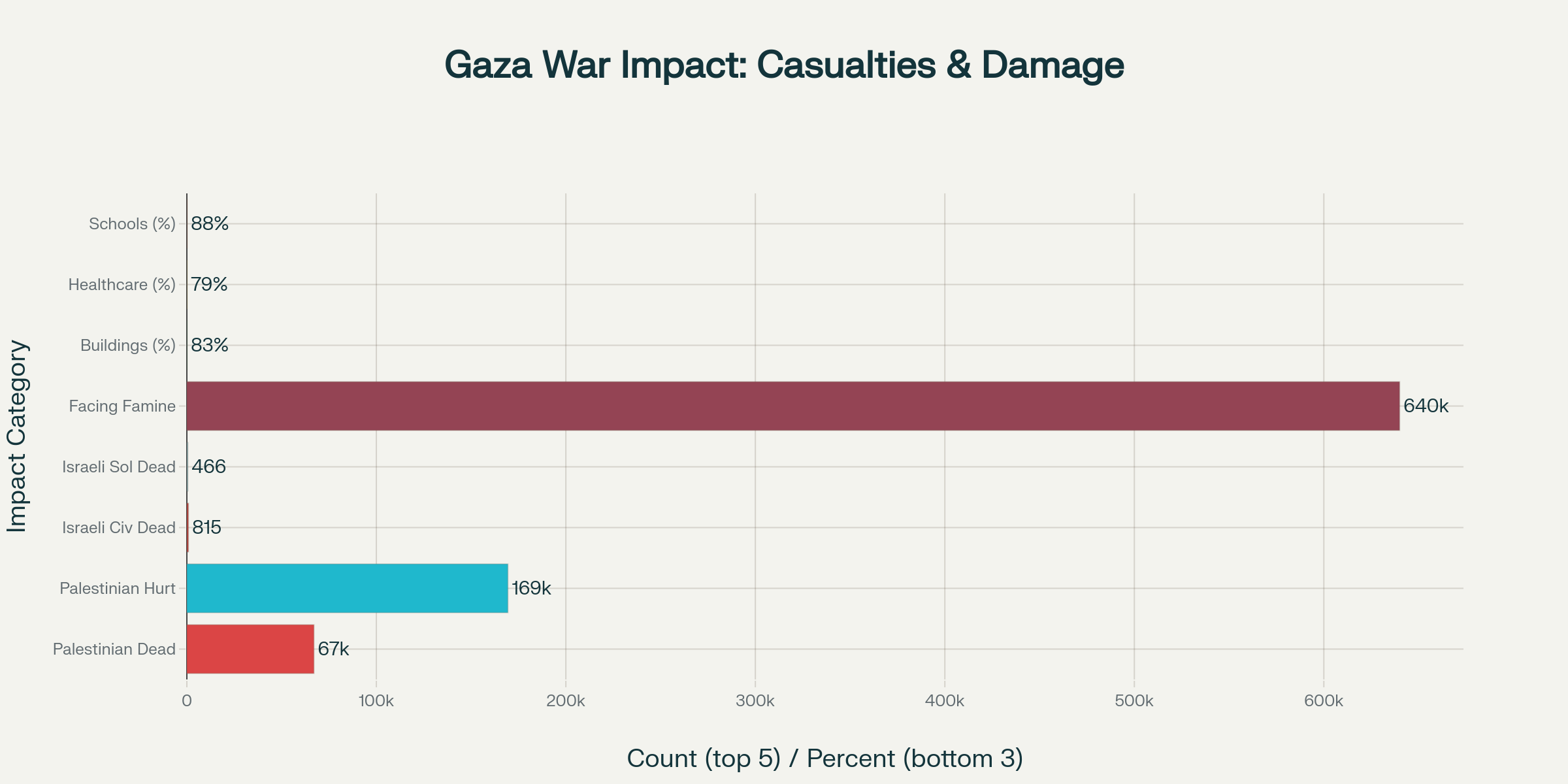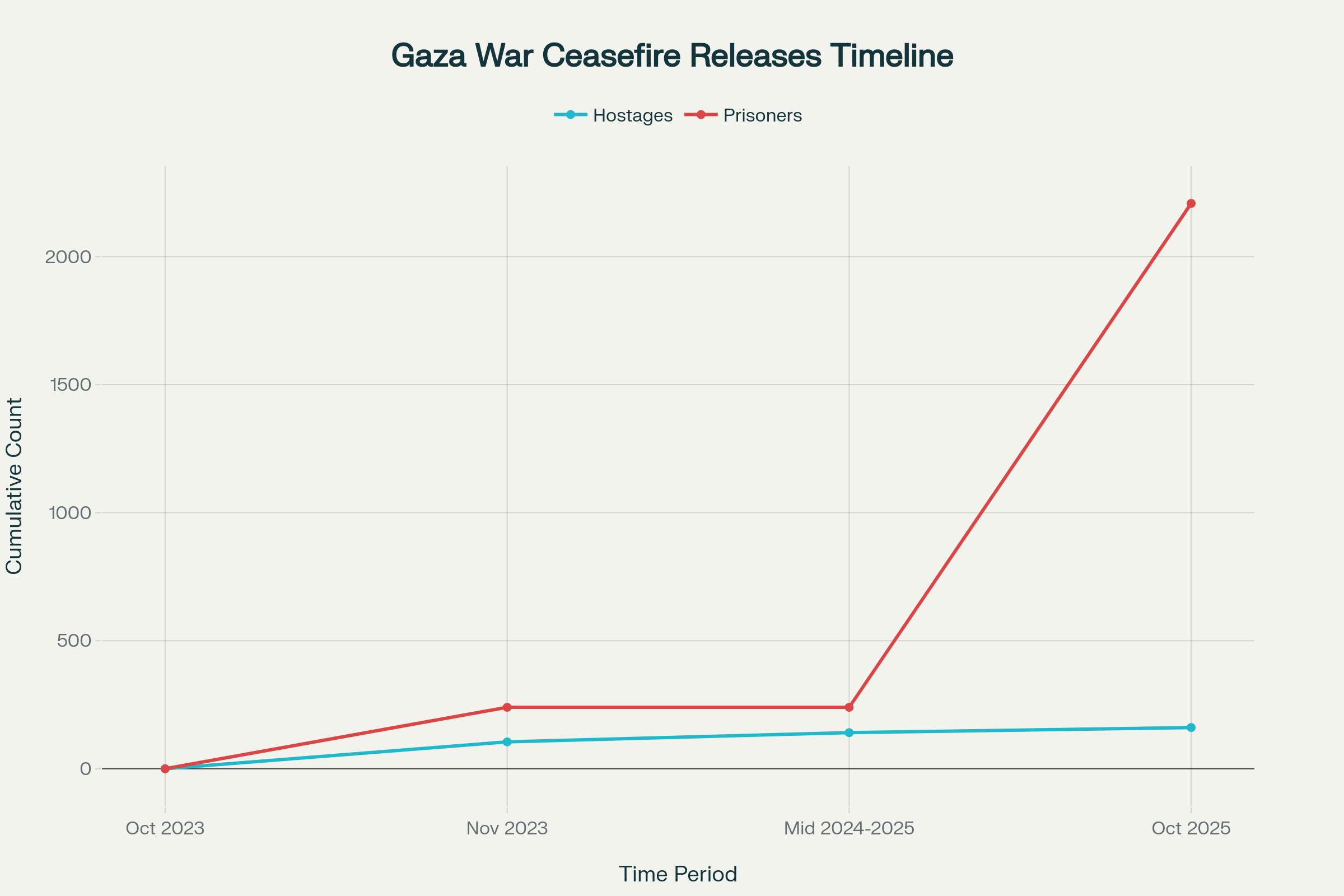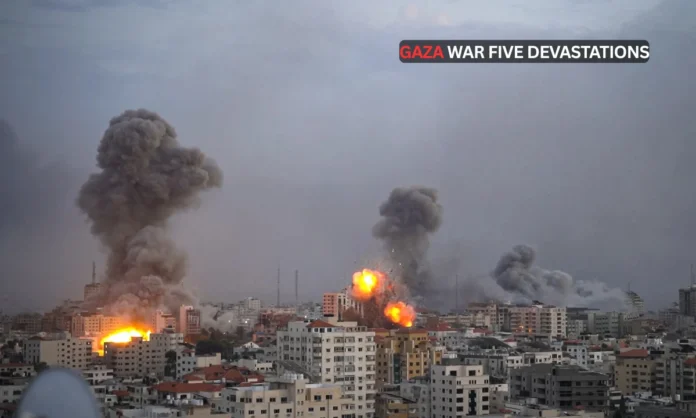Key Highlights
- The Israel Gaza war ceasefire facilitated the release of 20 remaining living Israeli hostages in exchange for 1,968 Palestinian prisoners and detainees
- Official data shows 67,075 Palestinians killed and 169,430 injured out of Gaza’s pre-war population of 2.2 million people
- Famine conditions affect over 640,000 people in Gaza, with WHO confirming the first official famine declaration in the Middle East region
Opening Overview: The Path to Ceasefire
The Israel Gaza war ceasefire represents the culmination of President Donald Trump’s 20-point peace plan, ending two years of unprecedented destruction and humanitarian crisis that fundamentally transformed the Gaza Strip. This Israel Gaza war ceasefire came into effect on October 10, 2025, after intensive negotiations involving the United States, Egypt, Qatar, and Turkey, marking the most significant diplomatic breakthrough since the conflict began on October 7, 2023.
The conflict’s scale becomes apparent when examining official casualty data: the Israel Defense Forces have killed and seriously injured more than 10% of Gaza’s population through direct violence and infrastructure destruction, according to Brown University‘s Costs of War project. The Israel Gaza war ceasefire negotiations accelerated after Trump’s September 29, 2025 proposal, which included immediate hostage release, Israeli withdrawal, Hamas disarmament, and establishment of a technocratic transitional government.
Initial phase implementation of the Israel Gaza war ceasefire demonstrated the agreement’s complexity, with Hamas releasing all 20 remaining living hostages while Israel freed 1,968 Palestinian detainees, including 250 serving life sentences. The Israel Gaza war ceasefire framework allows for massive humanitarian aid influx and enables displaced Palestinians to begin returning to northern Gaza, though reconstruction challenges remain immense.

Gaza War Impact: Casualties and Infrastructure Destruction Statistics
Hamas Attack and Israeli Military Response
- The October 7, 2023 Hamas attack killed 1,195 people in Israel, with 815 civilians among the casualties
- Hamas fighters infiltrated Israel with approximately 5,600 combatants, taking 251 hostages back to Gaza
The unprecedented Hamas attack on October 7, 2023, during the Jewish festival of Simhat Torah, fundamentally altered Middle Eastern security dynamics and triggered the current Israel Gaza war ceasefire negotiations. Hamas combatants used coordinated rocket barrages to cover their infiltration into Israeli territory, systematically targeting kibbutzim and the Nova music festival where civilians had gathered for celebrations.costsofwar.watson.
Official Israeli government data confirms that 1,195 people were killed during the Hamas attack, with 815 identified as civilians representing 68% of casualties, demonstrating the attack’s deliberate targeting of non-combatant populations. The attackers’ strategic planning included taking 251 hostages back to Gaza, creating the complex prisoner exchange dynamics that would eventually characterize the Israel Gaza war ceasefire negotiations.
| Conflict Statistics | Israeli Side | Palestinian Side |
|---|---|---|
| Civilian Casualties | 815 killed | 67,075 killed (total) |
| Military Casualties | 466 soldiers killed | Not specified |
| Injured | 2,952 soldiers | 169,430 total |
| Hostages/Prisoners | 251 taken hostage | 1,968 released in ceasefire |
Israel’s immediate military response escalated rapidly from airstrikes on October 7 to a formal war declaration on October 8, 2023, launching what would become one of the most intensive bombing campaigns in modern warfare history. The Israeli Defense Forces’ ground invasion began on October 27, 2023, with operations expanding throughout Gaza’s 365 square kilometers, ultimately leading to the current Israel Gaza war ceasefire after nearly two years of continuous combat.
The scope of Israel’s military response created conditions that international observers would later cite as contributing factors in the Israel Gaza war ceasefire negotiations, including widespread infrastructure destruction affecting energy, water, sanitation, agriculture, housing, and healthcare systems. Israeli military officials acknowledged that their operations resulted in 466 soldiers killed during Gaza combat operations and 2,952 injured, figures that influenced domestic Israeli support for the Israel Gaza war ceasefire agreement.
Hostage Crisis and Prisoner Exchange Dynamics
- A total of 251 hostages were taken to Gaza on October 7, 2023, with complex negotiations spanning nearly two years
- The final exchange under the Israel Gaza war ceasefire involved 20 living hostages for 1,968 Palestinian prisoners
The hostage crisis became the central humanitarian element driving Israel Gaza war ceasefire negotiations, with families of captives maintaining continuous pressure on Israeli leadership throughout the conflict period. Hamas’s strategic use of hostages as negotiating leverage created multiple temporary truces, including the November 2023 exchange that freed 105 hostages in return for 240 Palestinian prisoners.

Hostage and Prisoner Exchange Timeline During Gaza War
Official records show that 251 people were taken hostage during the October 7 attack, with ages ranging from infants to elderly individuals, creating unprecedented complexity in Israel Gaza war ceasefire discussions. The Israeli government confirmed that 117 hostages were killed during captivity, with some deaths occurring during Israeli military operations in Gaza, adding urgency to Israel Gaza war ceasefire negotiations.
The final hostage release under the Israel Gaza war ceasefire agreement demonstrates the deal’s comprehensive scope: Hamas freed the 20 remaining living captives while beginning repatriation of 28 deceased hostages’ bodies over subsequent phases. Israel’s reciprocal prisoner release included 1,968 Palestinians, with 250 serving life sentences and 1,718 serving shorter terms, representing the largest prisoner exchange in Middle Eastern history.
International mediation proved essential for Israel Gaza war ceasefire hostage negotiations, with Qatar, Egypt, and the United States maintaining separate communication channels with Hamas leadership throughout the conflict. The Trump administration’s direct involvement accelerated final Israel Gaza war ceasefire discussions, with President Trump’s October 14 Sharm el-Sheikh summit attended by 27 world leaders emphasizing international commitment to implementation.
Humanitarian Crisis and Destruction Assessment
- WHO confirmed famine conditions affecting 640,000 people in Gaza as of August 2025
- UN data shows 83% of Gaza’s buildings damaged or destroyed, requiring $70 billion reconstruction
The humanitarian catastrophe in Gaza reached unprecedented levels, with the World Health Organization declaring famine conditions for the first time in the territory on August 22, 2025, directly influencing Israel Gaza war ceasefire negotiations. WHO Director-General Tedros Adhanom Ghebreyesus confirmed that 640,000 people faced catastrophic food insecurity, representing nearly one-third of Gaza’s remaining population.
| Infrastructure Damage Assessment | Percentage Affected | Absolute Numbers |
|---|---|---|
| Buildings damaged/destroyed | 83% | ~183,000 structures |
| Healthcare facilities damaged | 79% | 35 of 44 facilities |
| Schools damaged | 88% | 625 of 710 schools |
| Universities completely destroyed | 100% | All 12 universities |
| People facing famine conditions | 29% of population | 640,000 people |
United Nations assessments document that 83% of Gaza’s buildings suffered damage or complete destruction, creating massive displacement affecting 1.9 million people and necessitating the $70 billion reconstruction estimate that became part of Israel Gaza war ceasefire planning discussions. The destruction included 79% of healthcare facilities, 88% of schools, and complete elimination of universities, creating long-term challenges that the Israel Gaza war ceasefire agreement must address.
Official casualty data from Brown University’s Costs of War project shows 67,075 Palestinians killed and 169,430 injured, with women and children comprising 70% of identified casualties, statistics that international mediators cited during Israel Gaza war ceasefire negotiations. The Gaza Health Ministry’s casualty reporting, which UN agencies and international observers consider reliable, documented systematic targeting of civilian infrastructure throughout the conflict period.
Israel’s complete aid blockade from March through May 2025 exacerbated humanitarian conditions, with only partial restoration of supplies contributing to famine conditions that accelerated Israel Gaza war ceasefire diplomatic pressure. The UN Office for Coordination of Humanitarian Affairs documented that average daily aid truck entries fell from pre-war levels of 500 trucks to fewer than 100 during critical months, directly contributing to malnutrition and disease outbreaks.
Regional Conflict Expansion and International Response
- Iran launched direct missile attacks on Israel twice in 2024, expanding the conflict beyond Gaza
- Lebanon’s Hezbollah conducted sustained rocket campaigns, resulting in a separate two-month war in 2024
The Israel Gaza war ceasefire emerged within a broader regional conflict involving Iran’s network of proxy forces across multiple fronts, demonstrating the war’s expansion beyond Palestinian territories. Hezbollah’s sustained rocket attacks from southern Lebanon created a second active front, forcing Israel to fight simultaneous campaigns and contributing to domestic pressure for the Israel Gaza war ceasefire agreement.
Iran’s direct military involvement escalated dramatically with two major missile and drone attacks on Israeli cities in 2024, marking the first time since 1980 that Iran directly targeted Israeli territory with conventional weapons. The June 2025 12-day war between Israel and Iran included Israeli strikes on Iranian military and nuclear facilities, with Iran responding with sustained drone and missile barrages targeting Tel Aviv, Jerusalem, and Haifa.
Yemen’s Houthi rebels expanded the conflict to international shipping lanes, targeting vessels in the Red Sea and Gulf of Aden while conducting missile attacks on Israeli territory, creating global economic implications that influenced Israel Gaza war ceasefire international negotiations. The Houthis’ disruption of approximately 12% of global trade through Red Sea shipping routes generated international pressure for comprehensive regional settlement including the Israel Gaza war ceasefire.
The International Criminal Court’s November 2024 arrest warrants for Israeli Prime Minister Benjamin Netanyahu and former Defense Minister Yoav Gallant for alleged war crimes created diplomatic isolation that contributed to Israel’s acceptance of Israel Gaza war ceasefire terms. Additionally, the UN Commission of Inquiry’s September 2025 genocide determination against Israel generated increased international pressure for immediate Israel Gaza war ceasefire implementation.
Final Perspective: Sustainable Peace or Temporary Respite
The Israel Gaza war ceasefire represents more than a temporary halt to hostilities; it establishes a framework for addressing the fundamental issues that have defined Israeli-Palestinian relations for decades. President Trump’s comprehensive 20-point plan addresses immediate humanitarian needs while creating mechanisms for long-term political resolution, including Hamas disarmament and establishment of technocratic governance.
Implementation challenges for the Israel Gaza war ceasefire remain substantial, with reconstruction costs estimated at $70 billion and complex coordination required between Israeli authorities, Palestinian leadership, and international donors. The agreement’s success depends on maintaining international commitment to Gaza’s reconstruction while ensuring security arrangements prevent future escalation similar to the October 7 attack.
The broader regional implications of this Israel Gaza war ceasefire extend beyond Palestinian territories, potentially influencing Iran’s proxy network strategy and creating opportunities for normalization between Israel and Arab states. Trump administration officials indicate that Gaza demilitarization represents only the initial phase of comprehensive Middle East peace initiatives, suggesting the Israel Gaza war ceasefire could catalyze broader regional agreements.
The human cost documented throughout this conflict, over 67,000 Palestinian deaths, 1,195 Israeli deaths, and massive displacement affecting millions, underscores the critical importance of ensuring this Israel Gaza war ceasefire transitions into sustainable peace rather than temporary respite before renewed violence.


